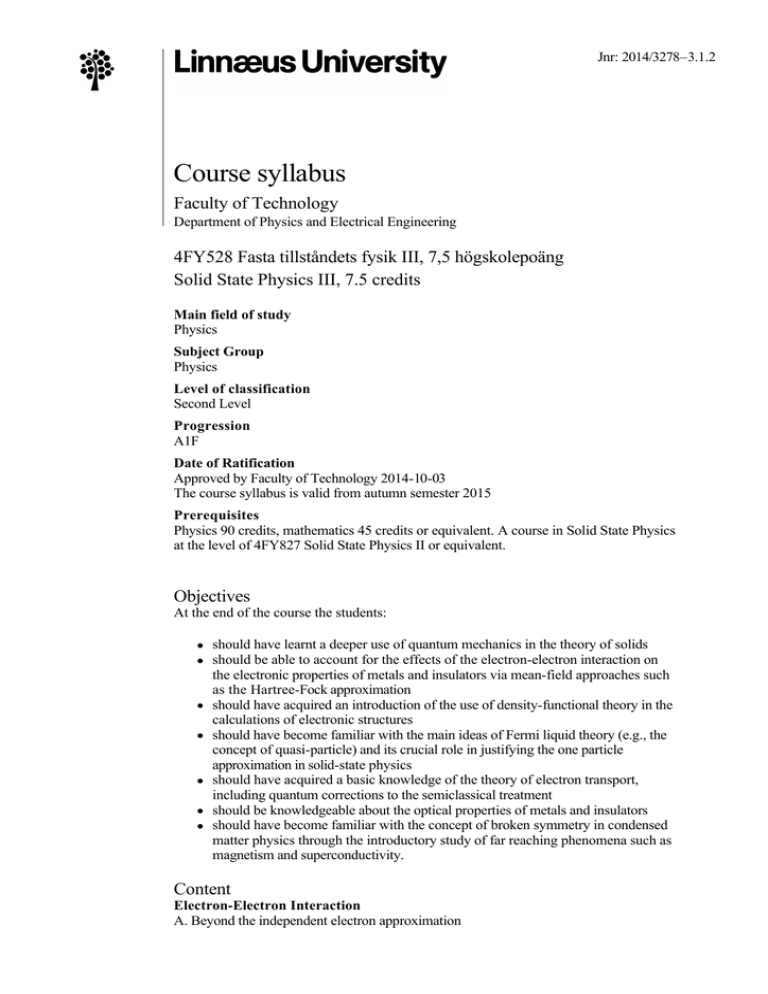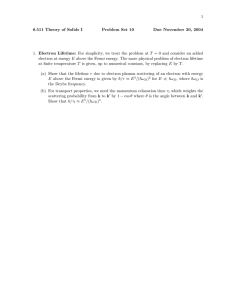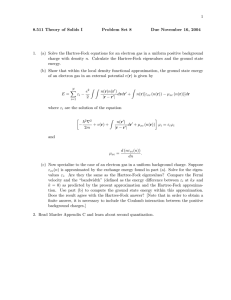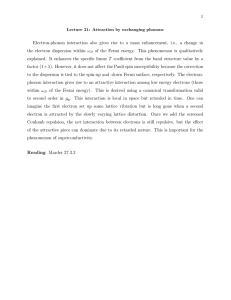Course syllabus
advertisement

Jnr: 2014/3278–3.1.2 Course syllabus Faculty of Technology Department of Physics and Electrical Engineering 4FY528 Fasta tillståndets fysik III, 7,5 högskolepoäng Solid State Physics III, 7.5 credits Main field of study Physics Subject Group Physics Level of classification Second Level Progression A1F Date of Ratification Approved by Faculty of Technology 2014­10­03 The course syllabus is valid from autumn semester 2015 Prerequisites Physics 90 credits, mathematics 45 credits or equivalent. A course in Solid State Physics at the level of 4FY827 Solid State Physics II or equivalent. Objectives At the end of the course the students: l l l l l l l should have learnt a deeper use of quantum mechanics in the theory of solids should be able to account for the effects of the electron­electron interaction on the electronic properties of metals and insulators via mean­field approaches such as the Hartree­Fock approximation should have acquired an introduction of the use of density­functional theory in the calculations of electronic structures should have become familiar with the main ideas of Fermi liquid theory (e.g., the concept of quasi­particle) and its crucial role in justifying the one particle approximation in solid­state physics should have acquired a basic knowledge of the theory of electron transport, including quantum corrections to the semiclassical treatment should be knowledgeable about the optical properties of metals and insulators should have become familiar with the concept of broken symmetry in condensed matter physics through the introductory study of far reaching phenomena such as magnetism and superconductivity. Content Electron­Electron Interaction A. Beyond the independent electron approximation B. The Hartree­Fock approximation C. Screening D. Landau's Theory of a Fermi Liquid Content Electron­Electron Interaction A. Beyond the independent electron approximation B. The Hartree­Fock approximation C. Screening D. Landau's Theory of a Fermi Liquid Electron transport A. Dynamics of Bloch electrons B. Transport phenomena and Fermi liquid theory C. Microscopic theory of conduction Magnetism A. Introduction B. Magnetization and magnetic susceptibility C. Diamagnetism and paramagnetism in solids D. Exchange E. Spin Hamiltonian and Heisenberg model F. Magnetism in Metals G. Magnetic Ordering Superconductivity A. Fundamental properties B. Electrodynamics of superconductors C. The BCS Theory Optical Properties of Solids A. Macroscopic Theory B. Optical modes in ionic crystals C. Interband Transitions D. Optical properties of Metals Type of Instruction The teaching consists of lectures and tutorials. Students can also register for the “distance” version of the course and follow the course via the internet. IT support and technical information: Email and web connection. Real­ time and recorded lectures on course homepage. Examination The course is assessed with the grades A, B, C, D, E, Fx or F. The grade A constitutes the highest grade on the scale and the remaining grades follow in descending order where the grade E is the lowest grade on the scale that will result in a pass. The grade F means that the student’s performance is assessed as fail (i.e. received the grade F). Assessment of student performance is made through written test and oral examinations and presentation of mandatory assignments. Reexamination will be offered within six weeks under the regular semester periods. Course Evaluation A course evaluation will be carried out and compiled after the course is completed. The compilation will be presented to the current board as well as to the students and filed by the coordinating department. Credit Overlap 4FY828 Solid State Physics III, 7.5 credits Other Grade criteria for the A–F scale are communicated to the student through a special document. The student is to be informed about the grade criteria for the course by the start of the course at the latest. Required Reading and Additional Study Material Main references 1.Ashcroft, N. W. and Mermin, N.D., Solid State Physics, Saunders College, 1976. Grade criteria for the A–F scale are communicated to the student through a special document. The student is to be informed about the grade criteria for the course by the start of the course at the latest. Required Reading and Additional Study Material Main references 1.Ashcroft, N. W. and Mermin, N.D., Solid State Physics, Saunders College, 1976. 2.Marder, M. P, Condensed Matter Physics, J. Wiley & Sons, 2000. Other recommended references Anderson, P.W., Concepts in Solids, Addison­Wesley, 1963. deGennes, P.G., Superconductivity of Metals and Alloys, Addison­Wesley, 1966. Harrison, W.A., Solid State Theory, McGraw­Hill, 1970 Kittel, C., Introduction to Solid State Physics, 7th Ed., John Wiley, 1995. Kittel, C., Quantum Theory of Solids, 2nd Revised Ed., John Wiley, 1987. Landau, L.D. and Lifschitz, E.M., Quantum Mechanics, Addison­Wesley, 1958. Mattis, D.C., The Theory of Magnetism I, Springer­Verlag, 1988. Sakurai, J.J., Modern Quantum Mechanics, Addison­Wesley 1994. Schrieffer, J.R., Theory of Superconductivity, Addison­Wesley, 1988.




